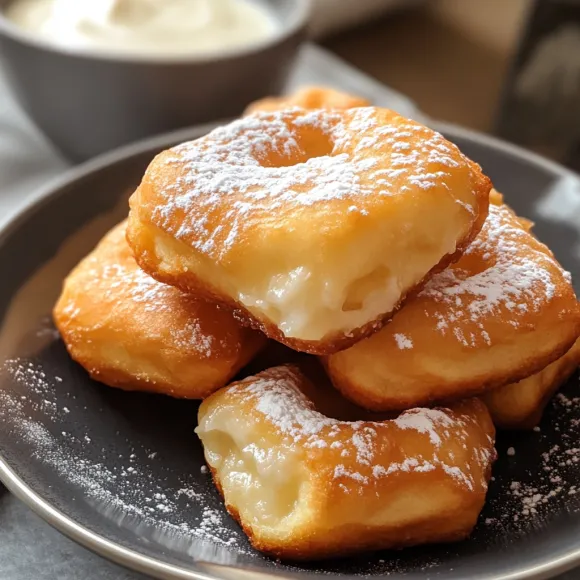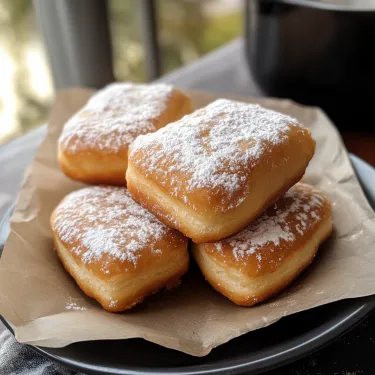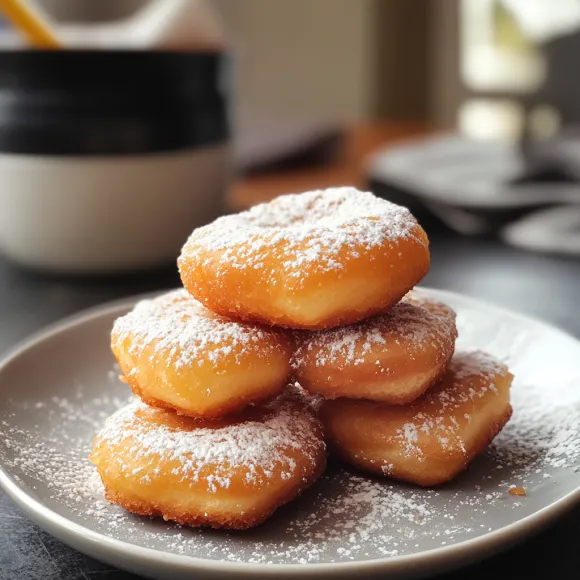 Save
Save
The subtle perfume of vanilla transforms classic French beignets into a truly dreamy treat. Each soft bite is light as air with a whisper of golden crust and generous clouds of powdered sugar. These beignets come together with pantry basics and a bit of hands-on love for a breakfast or dessert that always wins hearts in my home.
I made these for my nephew’s birthday brunch and watched everyone go back for seconds before they’d touched anything else on the table. If you love a little nostalgia with your sweets these beignets will feel like magic.
Ingredients
- All purpose flour: gives lift and the necessary structure Look for unbleached for best flavor and texture
- Granulated sugar: adds gentle sweetness Try organic if available for more complex notes
- Active dry yeast: delivers that essential rise Always check the expiration date so your dough gets fluffy
- Salt: balances the sweetness Choose fine sea salt for even dispersion
- Warm milk: helps activate the yeast Use whole milk for rich results
- Unsalted butter melted: provides flavor and softness High quality butter shines through in simple doughs
- Pure vanilla extract: infuses each bite with aromatic depth Go for real vanilla for the best fragrance
- Vegetable oil for frying: keeps the beignets light and crisp Choose a neutral oil with a high smoke point
- Powdered sugar: finishes each beignet with a melt in your mouth topping Sift first for the silkiest effect
Step by Step Instructions
- Prepare the Dry Ingredients:
- In a large mixing bowl whisk together the flour granulated sugar yeast and salt Make sure everything is evenly combined so the yeast will be distributed throughout the dough
- Mix the Wet Ingredients:
- In a separate bowl combine the warm milk melted butter and vanilla Stir well The mixture should be warm to touch not hot This is important so the yeast can activate
- Combine Dry and Wet Ingredients:
- Slowly stream the wet mixture into your dry ingredients Stir the dough with a wooden spoon until no flour streaks remain It will look and feel a bit sticky at first but that is perfect for soft beignets
- Knead the Dough:
- Turn the dough out onto a lightly floured surface Begin kneading with your palms fold and press until the dough becomes smooth and stretchy This will take about eight to ten minutes Add only a touch more flour if needed to prevent sticking
- First Rise:
- Put the kneaded dough in a greased bowl turning once so it is coated on every side Cover with a clean towel and let rise in a warm place for ninety minutes The dough should double in size and feel airy to the touch
- Shape the Beignets:
- Punch down the risen dough and gently roll it out to about a quarter inch thick Use a sharp knife or pizza cutter to slice into two inch squares Try to keep them evenly sized so they cook at the same rate
- Heat the Oil:
- Pour vegetable oil into a heavy based pot until it is about two inches deep Heat over medium high and monitor with a thermometer The oil is ready when it reaches three hundred sixty degrees and bubbles gently around a test scrap of dough
- Fry the Beignets:
- Working in batches lower the dough squares into the hot oil Fry for about one to two minutes per side using tongs to gently turn Remove when golden and puffed Drain well on a rack lined with paper towels
- Serve:
- While still warm dust the beignets with plenty of powdered sugar and arrange on a platter They are at their best eaten fresh and warm
- Cooling:
- If you need to wait before serving allow beignets to rest on a wire rack This keeps their outside crisp while the inside remains soft
 Save
Save
The scent of vanilla always takes me straight back to my grandmother’s kitchen where she would insist on pure extract I use the same bottle now and every beignet feels like a sweet hug from home
Storage Tips
Once fully cooled store extra beignets in an airtight container at room temperature They keep best for one day For longer storage freeze in a single layer then reheat gently in the oven at three hundred degrees for five to eight minutes to restore their pillowy texture
Ingredient Substitutions
If all purpose flour is not on hand bread flour can be used though the texture may become chewier For a dairy free version use almond or oat milk and substitute coconut oil for the butter Make sure any milk is warm not hot when mixing to keep the yeast active
Serving Suggestions
Serve these warm dusted with powdered sugar and paired with a fruit compote or a simple hot chocolate For a brunch spread try filling with jam or lemon curd by slicing open while warm and spooning in your favorite preserve
 Save
Save
A Little History
French beignets trace their roots to New Orleans where they arrived with French settlers centuries ago Today their sweet aroma drifts from street cafes all over the city Powdered sugar and pillow soft dough are their timeless signature
Common Recipe Questions
- → What type of flour works best for these beignets?
All-purpose flour provides the ideal structure and softness for classic French beignets.
- → Why is the dough kneaded for several minutes?
Kneading develops gluten, which gives the dough its light, chewy texture when fried.
- → How do I know if my oil is at the correct temperature?
Use a thermometer to maintain oil at 360°F; this ensures golden exteriors without greasy interiors.
- → Can I prepare beignets in advance?
They taste best fresh, but leftovers can be reheated in a 300°F oven to revive their texture.
- → How should the beignets be served?
Serve warm and dusted with powdered sugar, ideally right after frying for optimal texture and flavor.
- → What role does vanilla extract play?
Vanilla extract infuses the dough with a fragrant, sweet undertone that complements the sugar topping.
